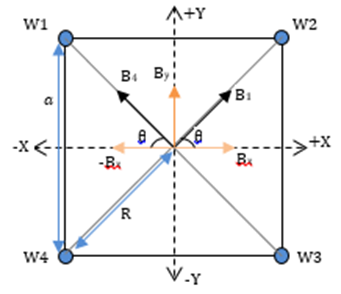The magnetic field at the center of the square is the vector sum of the magnetic field of all 4 wires. We use the Biot-Savart law to determine the magnetic field of the wires. For all the wires, the distance of the center from the wire is the same = R. It is related to edge length as
The magnetic field due to wire 1 is calculated as

The current in the wire 1 is directed out of the page. Hence the direction of the magnetic field at the center is determined using the right hand rule. According to the rule, the direction of this field will be in the counter clockwise direction. So at the center it will be along the diagonal of the square, perpendicular to R. Hence it will have components along +x and +Y direction.
The magnitude of the magnetic field will bethesame for wire 4. The direction of this field will be in the counter clockwise direction. But at the center, it will be along the diagonal such that it has components along -X and +Y direction (as shown in the diagram).
The magnitude of the magnetic field will bethesame for wire 2 and wire 3 as well. But for these wires, the current is going into the page. The direction of this field will be in the clockwise direction. At the center, the field due to wire 2 will be same as B4 and that for wire 3 will be same as B1.
Looking at the diagram, we can see that the x components of the four fields will be directed in opposite directions along the X axis. Henceit will get cancelled. The Y components of all the fields are along the same direction (+Y). Hence resultant field will be the sum of these components. The Y component will be given by
Hence the net magnetic field at the center is
Note here that;






